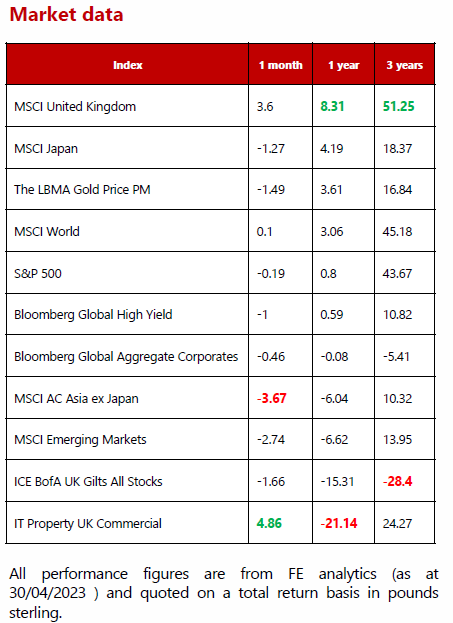United Kingdom - May 2023
Last month we had comebacks for our theme; this time around, rescues. It does feel as if a big budget drama/film is in the middle of shooting right now – so our themes fit nicely. Who is it that needs rescuing, if anyone, and from what? Is there a time frame (i.e. is the rescue time dependent), and most importantly (in the real world), is there anything to worry about?
In the interest of space this month, we will leave most of those questions as rhetorical. Suffice to say, there is ALWAYS something to worry about for investors – seeing through those concerns, concentrating on what lies ahead and (perhaps, most important of all) remaining focused on the why (why we are invested, why our goals are important, etc.) is key. Maybe a bank needed rescuing (have you heard of them?). It could be that an economy needed rescuing (were your investments heavily reliant on the success of that economy?). A rescue, by its very nature, is short term (what we would call tactical) – in reality, most investors are in it for the long term, taking strategic decisions. Have a plan, stick to it. If it is sent off course, get back on course asap.
Coming kicking and screaming back to the UK, are ‘weʼ in need of rescue? After the shock of Trussonomics in September/October 2022 and stubborn inflation, the (immediate) idea of a comeback/rescue seemed unlikely, yet the UK economy continues to defy predictions and has avoided recession thus far. Certainly not in need of rescue (though some sectors are under intense pressure). The Government (and it is safe to assume the Bank of England) recognises that citizens have had enough of taking the punishment for corporate arrogance/ineptitude and if we look across the pond, the ‘rescueʼ of the latest large(ish) bank failure was as painless as it could be for the general population – though not for shareholders (who presumably knew the risks).
It could still be that the UK (and whisper it not, maybe even the US) sees recessionary conditions in 2023. From a pricing perspective, there is certainly a lot of value around UK assets, which are at discounts for various reasons compared to global cousins/siblings. Sterling may have a part to play later this year but given the long- standing record of equity markets bottoming before the depths of recession/ economic shocks, we may not be far off conditions where modest and more regular (rather than volatile) share price growth can be expected in more sectors, and more market wide. We do like the look of UK smaller companies, and some high-quality names look set to deliver decent dividends among larger companies.
Term or word(s) to watch:
Biodiversity: a shortened form of two words: biological diversity. The term refers to the intricate web of ecosystems created by the natural word – animals, plants, fungi, and even microorganisms – working together to maintain balance and support life. Construction, pollution, and climate change threaten many different species of plants and animals and thereby threaten biodiversity. Such damage to the ecosystems we depend on (to provide pollination, clean water, carbon sequestration, and even protection against infectious disease) would almost certainly cause wide-reaching economic consequences for most investors. We expect biodiversity loss, like climate change and global warming, to be an increasingly important source of risks, and opportunities, for investors.
North America - May 2023
It remains difficult to discern the likely path for the economy from the data we are seeing. Inflation remains stubborn and there is weakness in some of the growth-related data – manufacturing remains in the doldrums and GDP is slowing, but there is not yet a slam dunk case for a recession. We still feel that the odds of it are high though and the hope is that if we contend with a moderate one it will remove the inflation problem at the same time. There is still significant fear that a sort of stagflation- lite will undo markets. We are seeing more layoffs come through, which might be an indicator that the robust labour market is going to start to show cracks. On a positive note, this monthʼs rate rise from the Fed could be the last of the cycle.
On the subject of rescues, the total assets of federally insured banks that have collapsed in 2023 is, in inflation-adjusted terms, more than the total of the 25 banks that failed in 2008!
Corporate results have been decent so far, while there are pockets of challenge, many have come in ahead of expectations, which is to say that the aggregate earnings level is falling less than expected. There have been pockets of weakness but the tech companies have impressed. Complacency would be unjustified though, as we are yet to see the economic fallout from the banking sector in the form of a credit crunch and given that any possible recession has been moved back, the impact on earnings is likely to have been kicked down the road too. Remember also that we are seeing consecutive quarterly declines in aggregate earnings and two consecutive year-on-year declines, so technically things are deteriorating. Margins are also very high and even if they are sustained, it is debatable whether earnings growth can be significantly achieved from here. Companies seem to have done a very good job at passing on costs and there are signs this has happened in excess of labour and other input costs, which has caused disquiet in certain quarters. We are now moving towards the delights of the debt ceiling. This is always a difficult event for markets to price – in a doomsday scenario it is potentially very bad news indeed if no deal is struck on borrowing limits but realistically the negotiations always result in a deal. This time things are likely to be even more stressful given that the Republicans have a majority in the House and are capable of bringing down the Speaker if they disagree with his proposals at any point in the negotiations. We would not position aggressively around this market event but it does lend credence to our already cautious approach.
US government bonds may come under some pressure over the next month, especially those where payments are due to be paid at some point in the middle of a potential stand-off (3-month rates are already well ahead of 1-month ones). When a deal is reached, this could provide challenges for government bonds too as there will be a significant increase in issuance. A time for cool heads and heightened vigilance.
The US market has bounced back to elevated levels and the opportunity cost of being underweight in this space, certainly over the next six months, looks low to us.
Europe - May 2023
It looks as if the hawks remain in the ascendancy in Europe and with inflation running well above target and expected to continue to do so throughout next year, more rate rises are coming. Core inflation (excluding food and fuel) accelerated to 5.6%, which suggests the initial effects of the energy shock have managed to embed themselves in the structure of the economy. Economic data points such as PMIs can be said to be holding up better than expected in some areas, but optimism is muted by the tighter monetary policy likely to be forthcoming. Real incomes in the Eurozone fell 6.5% from 2020-22 and by the end of next year are still expected to be 6% below where they were in 2000. Obviously, this is a story that is repeated elsewhere globally, though it is more acute in Europe than elsewhere.
Though Europe and her equities have withstood the appalling events in Ukraine, there could yet be negative developments on this front. May and June are expected to see offensives from both sides and there is still no meaningful dialogue suggesting the prospect of a ceasefire. China has supposedly made overtures to both sides, but we are not optimistic on this point. The proximity to the conflict was a headwind for European equities at the start of hostilities last year and sentiment is vulnerable should the conflict move on to another level. The adaptation of energy policy has been helpful and lower natural gas prices and restocking (accompanied by a mild winter) have allowed for a truly awful outcome to be avoided. Next winter may yet cause problems though.
European companies look to be valued reasonably fairly and discounts to their US equivalents are substantial across all sectors but that is to be expected given the elevated valuation levels on the US index, the S&P 500. If we do see a turn away from US dominance, then there is a decent chance Europe will be one of the main beneficiaries. It might also be argued that the European banking sector is in a better place than it is in the US with tighter regulation and stickier deposit bases helping matters – though there will undoubtedly be consequences everywhere if more ‘complicationsʼ materialise. Indeed, the most recent data on credit availability and lending in Europe already suggests tightening.
Positions are held – we have exposure both through geographic and thematic focused funds.
Dogs have more than earned their title as ‘manʼs best friendʼ. Given that our four-legged heroes have a sense of smell one hundred thousand times better than humans, they play a crucial role in search and rescue missions. This was illustrated earlier this year following the devastating earthquake in Turkey. In order to thank them for their efforts, the rescue dogs were treated to first and business-class travel by Turkish Airlines on their journey home. In search missions for trapped people, dogs account for around 70% of the search effort while human rescuers do around 30%. Thank you to all the very good boys (and girls)!
Rest of the world - May 2023
Inflation data from Japan released last month surprised investors, jumping from the 3.2% previous reading in March where it was expected to stay, up to 3.5% – a level not seen in Japan for over forty years. While this level is low compared to the UK and other major markets, Asiaʼs second largest economy has been trapped in a period of deflation for decades and this inflation is welcomed by the Central Bank. Having a positive inflation figure should help unlock parts of the Japanese economy by promoting consumer spending on large purchases, which in deflation times would be put off until later (when the price fell).
Given the above, it is no surprise that the Bank of Japanʼs (BoJ) interest rate policy differs drastically from the rest of the world. While the US Federal Reserve, European Central Bank and Bank of England have all been hiking rates, the BoJ has kept rates negative, having gone to -0.10% in January 2016 and has been in the market buying bonds at the ten-year level to keep the yields between positive and negative 0.50% of this level (a policy known as yield curve control).
Last month saw newly appointed Bank of Japan Governor Kazuo Ueda oversee his first policy meeting. No changes were announced to the headline policy, which was expected, but the commentary on markets suggested that BoJ now sees inflation having become entrenched, estimating it will be around 2.5% in 2023 and between 1.5% and 2.0% in the next two years. Accordingly, the BoJ announced a review of their current policies, which will last around 18 months. During this period, we expect that the yield curve control policy will be loosened.
Generally, this is positive news for Japan, which also is benefiting from stock market reforms, including a rearrangement of listing categories last year, encouraging further focus on shareholder returns. While there is a lot to like about the region, Japan also faces challenges, not least the volatility of its currency, which given the different rate policy to other economies has moved away from it being somewhat of Asiaʼs safe haven currency. Demographic issues also continue to weigh on the economy, with an ageing population supported by a shrinking workforce.
Japan has had a number of false dawns over the last thirty years where markets have got excited only for the alleged catalyst purported to finally unlock Japanʼs value to disappear. It is then perhaps no surprise that Japanese equities remain under-owned according to the most recent Bank of America Global Fund Manager Survey Managers survey, with the average position 10% underweight.
Imagine spending 22 hours drifting in open water, specifically the rough seas off the coast of Japan. Thatʼs what one 69-year-old man survived in 2021 after his boat capsized in waters just off south-western Kagoshima. Rescuers who found the man called his survival a ‘miracle’.
We continue to have exposure to Japanese equities and are constructive on the outlook. While we would like to see international investors return to the region, Japanese equities being under-owned also limits the potential downside here.
Fixed income - May 2023
After ten increases beginning March 2022, the Federal Reserve (Fed) has potentially now arrived at the end of its rate hiking cycle. Mayʼs 25 basis points increase takes the Fed Funds Rate to a range of 5-5.25%, a cumulative increase of 500 basis points since the process began. As ever, the language associated with the rise was the key focus for investors. Previously there had been talk of ‘additional policy firmingʼ – that phrase was watered down this time, still leaving the door for further action open but adding a dependency on forthcoming data points such as credit conditions, which will likely lead to an economic slowdown.
Those data points are starting to show some signs of weakness; US inflation is cooling, credit conditions are tightening (unavoidable following the issues at several large US lenders) and while unemployment is at cycle lows, recent data from the US Bureau of Labor Statistics shows job openings beginning to fall. Taking all these factors together, financial markets (as at 4 May) are pricing a 93% chance of rates being held at the next rate setting meeting in June.
Rate rises are clearly negative for fixed income, expectations of future rate rises lead to higher bond yields, which depresses bond prices. Through 2022, and taking the widely followed Barclays Bloomberg Aggregate bond index as an example, in USD terms, global bonds fell over 16%. USD is used here, as a weaker GBP through 2022 masks the true extent of the fall, in GBP terms the fall is 5.7%.
Rate rises expectations get priced into yields in advance so there has been little immediate impact on bond yields of this more recent and possibly final rate hike. However, if we can now more connivingly see an end point, that removes an element of rate volatility –or the risk of bond yields spiking once more, sending bond prices notably lower. Instead, we have attractive bond yields and with the threat of a weaker global economy, rates at a level that allow major central banks scope to respond. For now, that may be a story for 2024 but it does reinforce the attraction of bonds after a tricky period.
As markets started to price in terminal, or peak, rates through Q4 2022 we began the process of markedly increasing our fixed income allocation. These are now at healthy levels, comprising a mix of high-quality US Treasury bonds and investment grade (the strongest) corporate bond issuers. We continue to analyse other bond sectors and may make further moves here but do remain conscious of how a slowing economy could detrimentally impact some issuers.
Gold - May 2023
Through April, the price of gold, trading consistently at levels over $2,000 per ounce, came within touching distance of its record high of $2,074 set in August 2020. At that time, fears a further wave of Covid-19 would result in a repeat of the unprecedented global turmoil witnessed in March 2020 sent prices of the precious metal soaring. As ever, when all else looks set to fail, investors turn to the ultimate store of value. This behaviour came to the fore again in early 2022 when Russia invaded Ukraine.
That all said, gold investment can be a volatile ride. As a non-yielding asset, gold tends to struggle as interest rates move higher – as seen through much of the remainder of 2022, when the price fell to a little over $1,600 per ounce. In such an environment, which also tends to coincide with a period of strong global growth, there is often less demand for the metal as other assets prove more attractive. Similarly, as a dollar denominated asset in a period of US dollar strength, the gold price often moves lower.
Recent price strength comes as we reach the end of the US rate hiking cycle. Allied to this are several more idiosyncratic factors. The failure of several US regional banks, and ongoing issues with deposit outflows, has sent investors flocking back towards gold. Additionally, concern is growing over a standoff surrounding the US debt ceiling. While the debt ceiling is typically lifted, a demand from Republicans to make stringent spending cuts to vote in favour of raising the limit brings a possibility the US Treasury could run out of cash. Such a scenario, which would see the Treasury unable to pay bondholders, could technically result in a US default and a financial market meltdown the likes of which we can only imagine. Highly unlikely, of course, but a great boon for gold in the short term.
One of the more interesting trends driving the gold price higher is de-dollarisation. The idea the US dollar could be supplanted as the global reserve currency (which we discussed in last monthʼs edition), potentially by the Chinese renminbi, is increasingly generating column inches in the press. Several countries have openly suggested settling trade in means other than the US dollar – some clearly have their own reasons, such as Russia who wishes to avoid US sanctions. However, others such as Saudi Arabia are increasingly looking towards China and recently agreed to settle oil trades between the two in the renminbi. This rotation towards China is also being echoed by developing economies such as Brazil under recently installed President Lula.
Granted, much of this may well be political noise but a weaker US dollar is certainly boosting gold and many central banks are using dollar weakness to liberally top up gold reserves – data from the World Gold Council shows that through 2022, total central bank purchases of gold were at the highest level on record (since 1950). The pattern so far this year suggests more of the same with largescale purchases reported by central banks in Turkey, Russia, China and India.
In 1998, the South Korea government, struggling to repay creditors, including an enormous $58 billion bailout package from an International Monetary Fund (IMF) led- coalition, launched a nationwide gold- collection campaign. South Koreans of all ages were asked to donate gold to help pay the debt. Around 3.5 million people came forward to donate 226 tons of gold, valued at $2.2 billion.
We maintain well-sized positions in physical gold throughout many of our portfolios. In times of uncertainty, it proves its worth, providing the ballast that many other assets cannot.
Technology - May 2023
The technology sector fell out of favour last year when rising US interest rates forced companies to become more frugal and cut back on digital advertising. Tech is generally viewed as a ‘growthʼ area that should struggle in a higher-rate environment. Growth stocks have projected cash flows weighted further in the future and as such are more sensitive to changes in discount rates. The future does indeed look challenging for growth companies but why then is the technology sector (as measured by the S&P Information Technology Index) up 20% year to date? And, why did earnings results from tech titans like Meta, Microsoft and Alphabet all exceed expectations?
The technology sector has developed over recent years and is now home to a plethora of companies with a range of different return profiles. It is a mistake to expect all companies within the broad sector to move in the same direction, instead the tech space is far more akin to the healthcare sector, which includes large defensive pharmaceutical companies but also high-growth, higher-risk biotechnology companies. It is important to understand that major technology companies have become business critical and essential for daily life and as such have defensive characteristics.
Over the first quarter of the year, the US S&P 500 returned 4.44% in £ terms and 7.36% in $ terms. However, this headline figures masks its lack of breadth; just 20 stocks (mostly mega cap technology companies) account for almost 90% of the gains. These technology giants are the antithesis of the blue-sky tech companies delivering meagre profits but promising significant growth.
We expect this divergence in tech companiesʼ performance to continue over the next couple of years.
Increasing reliance on technology is a long- term theme within portfolios. Exposure is gained by broad funds with a flexible mandate to tilt the underlying holds to suit the macroeconomic environment.
Developments in technology have become an invaluable rescue aid over the past decade. In 2002, Elizabeth Smart was kidnapped at age 14 from her home in Salt Lake City, Utah, and held in captivity for nine months before being rescued. Since then, she has been a vocal and active child safety advocate. Smart has recently partnered with the Portland-based tech company Q5id to launch the ‘Guardianʼ mobile app nationwide to help quickly locate missing children and adults.
Environment - May 2023
This April, veteran US car manufacturer General Motors (GM) made an important announcement alongside its first quarter earnings results. GM is teaming up with Samsungʼs battery manufacturing division, Samsung SDI, to build a new $3 billion car battery plant in the US. This is the first time GM and Samsung have worked together to manufacture batteries and is an important signal that GM is committed to scaling-up its electric vehicle (EV) production. GM currently own and operate three battery plants jointly with South Korean company LG Energy Solution; this new collaboration with Samsung should help to mitigate supply chain risk through diversification as well as lowering costs.
In the same announcement, GM confirmed plans to cease production of one of its older model EVs, the Chevrolet Bolt. At first this looks contradictory, why would GM discontinue one of their EV models at a time when they are actively trying to scale up their EV production? The clue was in the announcement, CEO Mary Barra said that the Bolt would be discontinued in late 2023 to make room for GM’s ‘new generation of electric vehicles’. The Bolt is a relic from an era when established US car makers made EVs in order to satisfy federal regulations and lower the fuel emissions of their overall fleet, not because they actually expected them to be popular with consumers.
It is fair to say that the Chevy Bolt was not exactly designed as a vehicle the majority of American car owners would actually want to buy. GM now sees the potential in the EV market and wants a bigger piece of the pie, aiming to become more competitive in the EV market by appealing to their mass market, making electric versions of popular pick-up trucks like the Silverado and the Sierra.
This news from GM is just one more piece of anecdotal evidence in favour of the EV market continuing to accelerate in the coming years. According to the International Energy Agency, over 2.3 million electric cars were sold worldwide in the first quarter of 2023, that is about 25% more than in the same period last year. Despite this impressive expansion, car manufacturers insist we have only scratched the surface of the potential growth.
Elon Muskʼs Twitter antics regularly attract attention these days but back in 2019 he was using the site to provide bespoke customer service to the stars. Tesla founder Musk came to singer/songwriter Sheryl Crowʼs rescue when car problems with her Tesla left her stuck in a parking lot. Musk talked her through a resolution via public tweets and presumably helped her avoid having to, ‘hitch a ride with a vending machine repairman’.
Within portfolios, we have specific exposure to companies set to enjoy a multi-year tailwind from global efforts to reduce emissions. This includes investment in leading battery technologies, transport sensors and semi-conductor manufacturers.


The Monthly Market Commentary (MMC) is written and researched by Simon Gibson, Richard Smith, Scott Bradshaw, Mark Moore and Lauren Wilson for clients and professional connections of Mattioli Woods and is for information purposes only. It is not intended to be an invitation to buy, or to act upon the comments made, and all investment decisions should be taken with advice, given appropriate knowledge of the investor’s circumstances. The value of investments and the income from them can fall as well as rise and investors may not get back the full amount invested. Past performance is not a guide to the future. Mattioli Woods is authorised and regulated by the Financial Conduct Authority.
The MMC will always be sent to you by the seventh working day of each month, usually sooner, is normally delivered via email, and is free of charge as the MMC is generally made available to clients who have assets under our management in excess of £200,000, and to all clients under our Discretionary Portfolio Management Service (DPM). Normally, the MMC costs £397 + VAT per annum. Professional advisers and their clients should contact us if they are interested in receiving a monthly copy.
Sources: All other sources quoted if used directly; except fund managers who will be left anonymous; otherwise, this is the work of Mattioli Woods.





